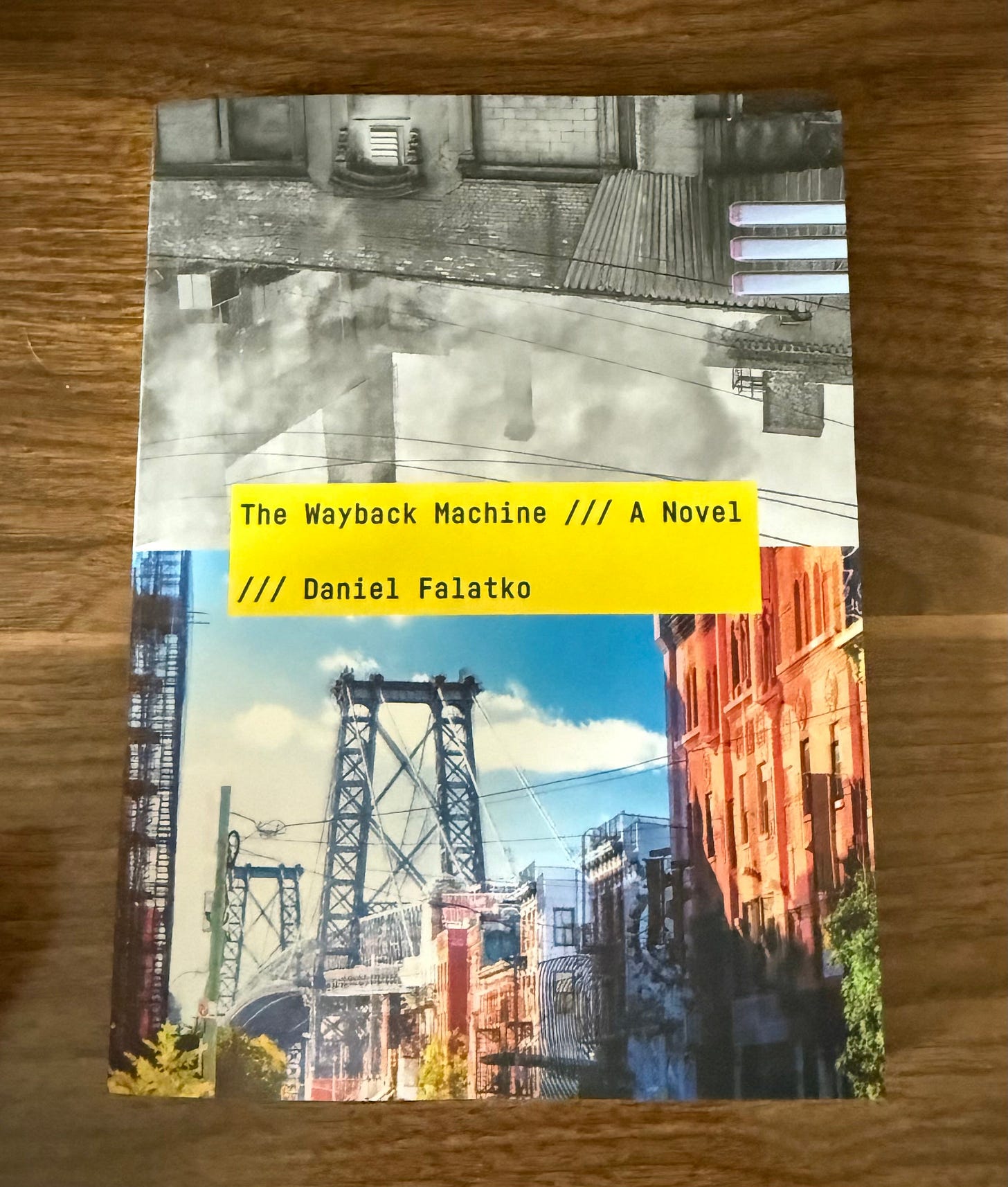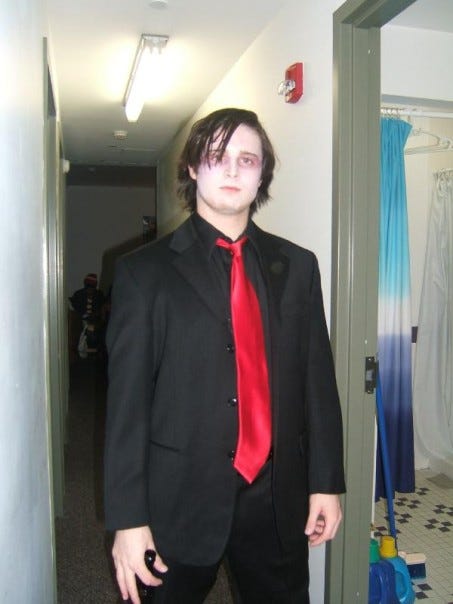This is part of Substack Summer for Summer 2025. You can read more about Substack Summer here.
Substack Summer Overview
Just the Facts - all the basic info about the book/novel/story
Pump the Tires1 - this is my bias disclaimer where I lay out what relationship I have, if any, with the Substack writer whose work I’m discussing. It works on a 1-4 scale; 1 being I barely know this person and 4 being you cannot trust a word I say.
Overview - this is my “review” of the work in question, including any:
Stick-taps - positive aspects I really enjoyed
Chirps - anything about the work that didn’t work for me
Overtime - miscellaneous thoughts and an update on the overall progress of the Substack Summer project.
Previous Entries:
Just the Facts

Title: The Wayback Machine
Author: Daniel Falatko (aka
Format: eBook. Paperback. (Read via paperback)
Genre: Satire, Thriller
Substack:
Length: 202 paper-pages.
Vinny’s Blurb: Part dark satire and part cat-and-mouse psych-thriller, The Wayback Machine pokes fun at mid-Millennial, indie-set nostalgia while also saving plenty of barbs for our current “culture” of ubiquitous podcasts, faux-activism, gentrification and identical coffeeshops. Wayback Machine asks what makes a culture authentic, what is its purpose, and is there any way to escape the Powers That Be?
Pump the Tires
🫥🙂⚫⚫ 2/4
Wayback Machine was one of the first newsletter I stumbled upon after venturing into LitStack. Falatko won me over with his auto-fiction tales of Philly and his casual raconteur style that made me feel like I could waste a solid evening at the bar with this guy. We do not go way back (sorry, I’m so sorry), but he’s boosted some of my work and I’m a big fan of his (Check out Rosie Hernandez if you haven’t already).
Overview
I cannot claim to have ever intentionally used cocaine or listened to the Strokes so I’m not a direct demographic bullseye for The Wayback Machine. BUT, I am familiar with the dirty-bathroom, sleazy rock-adjacent, basement show scene. My particular oeuvre erred toward emo2 and hardcore, punk and Warped Tour. I once picked a fight with the lead singer of Yellowcard; cosplayed the guy from My Chemical Romance for Halloween; and bootlegged Straylight Run demos. I installed OG Napster in the high school computer lab and Limewire on the family PC.

The Wayback Machine follows Nathan, a prominent blogger in the ‘00s indie scene who worked for cultural mags like Dagger and Bad Habits3. Nathan has just wrapped up a long stint in prison for drug trafficking charges and his identify has been mostly erased from the internet, except for breadcrumbs on the archive site Wayback Machine. Nathan has two goals: make some money and restore his good name.
I don’t have a copy of the DSM-5, because I’d prefer to write my own autobiography, but the marginalia I have for Nathan reads like excerpts: delusional, antisocial, narcissistic, paranoid, parasocial attachments, delusions of grandeur… Nathan isn’t technically our narrator, but in the close third perspective you can feel his paranoia creeping in from the edge of the page. And how’s that saying go? Just because I’m paranoid doesn’t mean they’re not out to get me.
I won’t spoil too much of the plot, but Nathan finds his way back4 via a popular podcast — the blogs of our time! — hosted by two Gen Z kids (Micah and Noah) that idolize and attempt to memorialize the ‘00s. With the help of their platform, Nathan succeeds in his two goals, but now he’s got a new problem: They know he’s out there, and now they’re coming to erase him for good.
Underneath the conspiracy theories, the cat-and-mouse game, and the backstory drip via the podcast (a brilliant and effective device), Wayback Machine raises a lot of interesting culture questions. Why are we nostalgic for eras we never experienced? Nathan got to see Nirvana live — why did I feel a pang of jealousy when I read that?
So much of nostalgia is less about the sounds or aesthetics of a period than it is about freedom, indiscretion and a feeling of youthful invincibility. All the messy bits either get swept under the rug or canonized via VH1. That’s part of the hipster — and wider New York City — allure: what if you never had to grow up? Falatko mentions the “transitory nature of its populace.” A friend who lived there said to me: “everyone in New York is taking a gap year from becoming a real adult.” It’s a city built on nostalgia, forever reinventing itself to align to the newest trends and burying its past beneath a Starbucks, “countless voids left in the wake of a senseless and merciless progress.” The city itself serves as a symbol of the transience of culture.5 Whether it’s the podcast’s nostalgia for indie-sleaze (cultural appropriation “didn’t yet exist”), or Nathan’s nostalgia for his former “spot” in the scene, Falatko deftly deconstructs the edifice of nostalgia, slowly poisoning the rose-tinted vision with the truth.
Truth is another big theme. Much like I mentioned narratives and stories and the power struggles of who gets to tell in Cubafruit, that is also present here in The Wayback Machine. There’s a cultural push-pull between the “right to be forgotten” and not wanting to be erased. And like Cubafruit, there is (to my reading) a similar conclusion: violence trumps truth.
Lastly, I want to talk about nihilism. There is a particular strain of it running through Wayback Machine and - to his credit - Falatko doesn’t give us a definitive answer on the ideology. He does present a particular interesting nuance, what I would call “capitalist nihilism.” Where nihilism states that “nothing matters…”, capitalist nihilism appends … “so long as it makes money.” Characters repeat lives like “all culture is trash,” “all culture is a fraud,” but these refutations of culture never feel wholly believable. If culture doesn’t matter, why start a blog or a podcast (or a Substack reviewing books)? Maybe it’s because we need to commodify any passion to pay the rent. “Jail low tippers.” A place where authenticity is a marketing tactic and prison is a welcome escape from the endless stream of mediocre options for dopamine.
Stick-taps
Falatko has an amazing talent for finding the right word; referring to a bar as “antiseptic,” or oversharing as “bloodlet[ting].” He’s got a real way with words and there’s a lot of great stuff at the sentence level in TWM.
I feel like there’s a lot coverage of LA vapidity and the valley vocal fry, but I have yet to read something that skewers NYC’s self-satisfied Trustafarian set better than The Wayback Machine. So many characters with no literal faces have imminently punchable faces nonetheless.
I enjoyed the namedropping of bands and band members from the scene. It did a good job of blurring the line between fiction and reality. It was also great to see my early-2000s critique of these bands (‘rich kids with fancy guitars’) echoed by Nathan.
It was not lost on me that Nathan is h(a)unted by his Bad Habits.
SPOILER: “I gave them names.” I gasped. Well down, Wayback.
Some killer lines:
“It’s like drinking in a dentist’s office.”
“The instinct then was not to “stan” the things you loved… It was to tear them down.”
“Fisher-Price Lou Reed-isms”
“ “Yea sure,” he said, unsurely. ” (An adverb. The fucking gall!)
“Perhaps they had been making an enemy of their future all along?”
Chirps
SPOILER: I didn’t buy the deus ex machina at the climax, but I did like that it ended up being a feint. I felt the elevation of Micah into heroine didn’t make sense and I’m glad Falatko had one last twist planned for the ending. That said, when she did appear at the end, I found myself wishing there had been more of her. Throughout the interspersed podcast bits, I saw her becoming the moral center of the novel, I think I was just missing one more link to get Micah to that end point.
SPOILER: I also thought there could’ve been more time building the villain. Falatko created facsimiles of real-life characters and for me that ended up being a red herring that distracted me from focus on his primary antagonist. Combining the three founders of Bad Habits into one (or maybe two if you wanted to keep the white nationalist bit separate) may have helped keep me focused on who is who.
This one is a personal grievance: I hate NYC as a setting. I hate how everyone who has ever lived in NYC expects people to care about NYC, to know the streets and neighborhoods and sub-neighborhoods of NYC. I also hate the Yankees.
McSorley’s fucks though.
Falatko does take us to some of the more interesting parts of NYC and has some fun needling the gentrification.
Overtime
had an article recently about unlikable characters and how there’s too much talk about likable/unlikable characters in literature when we’ve come to embrace anti-heroes, sociopaths, and sleazeballs in all other forms of media. The characters are unlikable throughout The Wayback Machine, few of them experiencing any intellectual or moral growth, and that makes Wayback a better novel. It is a strength, not a weakness. I was rooting for that dirtbag Nathan to get away with it even though I didn’t like him. Why?Probably some affection and a little too much nostalgia for that other dirtbag, pictured above.
If you are unfamiliar with this phrase, watch the first ten seconds on this video.
The best skewering of this genre I’ve seen.
Facsimiles of Pitchfork (I think) and VICE (I’m positive).
I promise this is the last one.
We spend less time in LA, but Falatko uses that to reflect NYC’s supposed authenticity against LA’s vacuity; a whitewashed pantomime of culture touchstones, curated and for sale. Falatko’s LA built amidst sprawling homeless encampments reminded me of Joseph Conrad’s “whited sepulcher” from Heart of Darkness.



Solid. I’ve enjoyed these summer Substack reviews you’re doing. I’m reading Cubafruit now and finished TWM a month or so ago. Enjoyed both.
Liked how much time you devoted in this review to nostalgia, right to be erased, the loss of being forgotten, etc. I’m a massive fan of those aspects of the book. One of the things I love so much about that entire theme in TWM is how transferable that is to people who grew up in small towns. It’s just far more aggressive, unrelenting and unforgiving in cities. I very much appreciated that I didn’t need to have lived in NYC to enjoy that about TWM. DF wrote TWM in a way that was reachable. And to your point re: setting, I’ve never lived in NYC and at times NY novels feel overdone. That said, NYC worked SO well in this one I can’t imagine the story anywhere else. I also can’t wait to read The Unmapping, which is set in NYC. All that to say, I’m starting to enjoy NYC on the page more, even if it has no stronger pull irl. That’s a stick tap for Le Wayback and any other writers who pull that off.
2/2, Vinny. You’re becoming my go to.